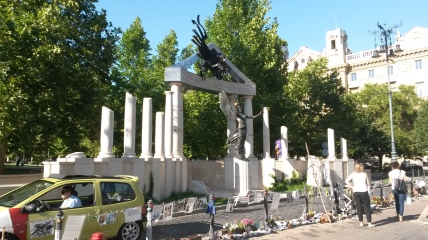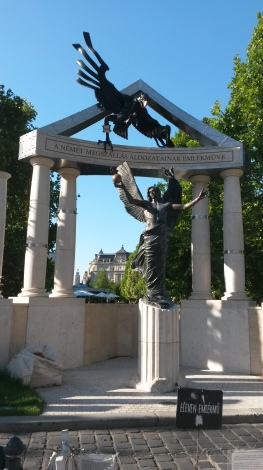On a recent trip to Budapest, Hungary I was astonished by the beauty of the city. The calm and majesty of Buda, the trendiness and liveliness of Pest, the weirdness of the local language, and the history of Budapest caught me off guard and really left a great impression on me.
Amongst all that, we discovered a memorial on Szabadság ter (Freedom Square). Built in memory of the victims of the nazi occupation, the monument is, however, the object of controversy since the start of its construction. It needs to be added that the erection of the memorial was finished during a night of July 2014, by workers who had been escorted and protected by 100 policemen.
The apple of discord
The monument is made of several elements: a statue of Archangel Gabriel, representing Hungary, and a gruesome imperial eagle representing the nazis. Built to commemorate the death of all the Hungarians following the invasion by Germany in 1944, the meaning of the installation is however harshly contested by the civil society and the opposition who invoke historical facts to counteract the government’s “official history”.
The construction raises number of questions: what role did the Hungarian government play in the Second World War? What was their bargain with Germany? Who did what? But above all, the question is: can a country who collaborated with offenders (here nazi Germany) be considered occupied? According to the monument, Hungary was yet another victim of Germany. According to its detractors, Hungary called for it by collaborating with Germany – the government played with the devil when they decided to take some distances when they realised the situation was getting bad and Germany was accumulating more and more losses.
What really happened? (for more, click here and here)
In November 1940, although not fascist himself, Miklas Horthy, the anticommunist regent and virtual dictator of Hungary, reluctantly aligned Hungary with Hitler, hoping to keep the country away from Soviet domination. Right-wing individuals also pushed for this option. When Germany turned onto Russia in 1941, they asked Hungary to mobilize their troops to support the war effort. The Hungarian 2nd Army was decimated by the USSR in 1943, following which Horthy looked into withdrawing from the alliance with Germany, and into building stronger connections with Western powers. Hearing about this plan, the Germans kidnapped Horthy and replaced him by Ferenc Szalasi, leader of the fascist Arrow Cross Party, who organised harsher repression against the Jewish populations. The country was finally liberated by the Red Army in December 1944.
Controversial memory
The memorial is clearly trying to separate Hungary from the nazis, saying that all the horrors that were committed had been done under threats and obligations, or perpetrated directly by the Germans. This is where memory counts; because the Hungarian civil society remembers the facts differently. The government’s version omits to say that deportations and terror started well before 1944 when Szalasi took power; Miklas Horthy passed a series of anti-Semitic laws from 1920, as well as organized the deportation of Jews. In addition, there were supporters of the fascist movement in Hungary who collaborated with the nazis, placed the Jews in ghettos and organised their deportations. 
The Hungarian population is split on the matter. When asked whether they agree with the monument, 38% say they are against, 38% in favour, the rest uncertain or neutral. There is therefore a need for political dialogue which includes all groups, parties and opinions, in order to define a common history for the country. An official dialectic cannot be made unilaterally by the government without the consent of the population.
Social activists have thus contested the memorial project from the beginning. Baffled by the fact the monument was still being built despite the fact that a fringe of the population demanded that a referendum would be organized to settle the question, which was rejected by the Parliament, they organized. The monument surroundings are now covered in memorabilia, artifacts, posters and explanations of why they oppose the installation. They also set up a space for people to discuss the problematic next to the statue. They offer a platform for discussion, thus doing what the government should have done.
Prime Minister Viktor Orbán and those who created and erected the monument are accused of “falsifying the Holocaust” by getting a monument “confusing the murderer and the victim” erected “in the shelter of the night.” [They] accused Orbán of dishonouring all Jewish, Roma and gay victims of the Holocaust, and added that it was “characteristic of the regime that it did not dare set up the statue of falsehood during the day.”(EurActiv) 
Memory is a powerful political tool which can be used to justify certain actions. Failing to recognize that the government of Hungary took part in spreading terror in Hungary before and during the Second World War is falsifying history. Horty most certainly acted to secure the interests of his country, hoping to be on the winning side for once. They probably felt pressured by their German ally to follow their lead. Those are mitigating factors, not excuses.
With the rise of Orban in Hungary accompanying the spread of far right movements across Europe, there is a need to explore history in order to build memories as close as the facts. History must not be allowed to be distorted for any reason, especially to justify xenophobic or racists policies.
flora

